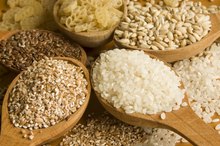What does fact checked mean?
At Healthfully, we strive to deliver objective content that is accurate and up-to-date. Our team periodically reviews articles in order to ensure content quality. The sources cited below consist of evidence from peer-reviewed journals, prominent medical organizations, academic associations, and government data.
- National Institute of Diabetes and Digestive and Kidney Diseases: Understanding Obesity
- National Institutes of Health: Healthy Eating Chart
The information contained on this site is for informational purposes only, and should not be used as a substitute for the advice of a professional health care provider. Please check with the appropriate physician regarding health questions and concerns. Although we strive to deliver accurate and up-to-date information, no guarantee to that effect is made.
How to Get a Huge Belly
Gaining abdominal weight isn't difficult but does require planning beyond eating cookies and avoiding the gym. Genetic makeup, lifestyle and body type determine where your body allocates excess fat. Although your entire body must gain weight to expand your belly size, certain strategies can enhance weight storage specifically in your midsection. Calorie sources and lifestyle can both expedite abdominal fat storage. Intentionally gaining weight in your midsection is risky but if you're determined to add to your belly pouch, understanding the causes and factors associated with weight gain will help maximize your belly size.
Eat more high-fat calories than you use. An excess of calories from any source increases fat stores, but according to the National Institutes of Health, heavily processed foods high in fat, sugar and sodium increase weight most rapidly 3. Examples of good belly-expanding foods include processed high-fat lunch meat such as bologna or pepperoni, cake, fruit bread, full-fat cuts of meat, and cream-based sauces or dressings such as ranch or sour cream. Remaining sedentary enables your body to store excess fat and calories.
How Many Calories Can You Burn Doing the Belly, Butt & Thigh Blasters Workout?
Learn More
Drink more alcohol 2. A 2005 study published in the International Journal of Obesity disproved the myth that only beer leads to a "beer belly." Researchers at the University College Medical School of London found that individuals who drank 21 or more units of alcohol per week had an increased waist circumference regardless of whether the alcohol was beer, wine, spirits or cocktails. Although all subjects gained abdominal weight, those who drank three or more beers a day showed especially significant increases in waist circumference.
Sleep less. A 2010 Dutch study found that the number of hours children slept was inversely related to their body mass index. A previous study conducted in Japan at the Niigata University School of Medicine in 1996 found that Japanese shift workers had a higher waist circumference than their day-working colleagues, despite similar diet and exercise regimens. Inadequate sleep strains your body and increases production of cortisol, a stress-related hormone that also regulates fat digestion. Excess cortisol in your body encourages weight gain.
Warnings
Limit your stomach size. According to the National Institute of Diabetes and Digestive and Kidney Diseases, having a waist circumference larger than 35 inches for a woman or 40 inches for a man significantly increases your risk of obesity-related health complications.
Related Articles
References
- International Journal of Obesity: Effect of shift work on body mass index: results of a study performed in 319 glucose-tolerant men working in a Southern Italian industry, 2003
- International Journal of Obesity: Alcohol and adiposity: effects of quantity and type of drink and time relation with meals, 2005
- National Institutes of Health: Healthy Eating Chart
- What causes obesity & overweight? Eunice Kennedy Shriver National Institute of Child Health and Human Development. Reviewed December 1, 2016.
- Karvonen-Gutierrez C, Kim C. Association of Mid-Life Changes in Body Size, Body Composition and Obesity Status with the Menopausal Transition. Healthcare (Basel). 2016;4(3):42. Published 2016 Jul 13. doi:10.3390/healthcare4030042
- Stress, cortisol and abdominal fat. The American Institute of Stress.
- Assessing Your Weight. Centers for Disease Control and Prevention. Reviewed May 15, 2015.
- The Health Effects of Overweight and Obesity. Centers for Disease Control and Prevention. Reviewed May 15, 2015.
- Abdominal fat and what to do about it. Harvard Health Publishing. Updated June 25, 2019.
Writer Bio
Christina Bednarz Schnell began writing full-time in 2010. Her areas of expertise include child development and behavior, medical conditions and pet health. She holds a Bachelor of Arts in international relations.









